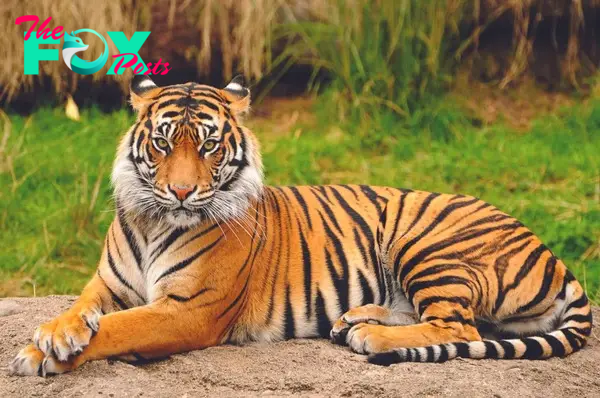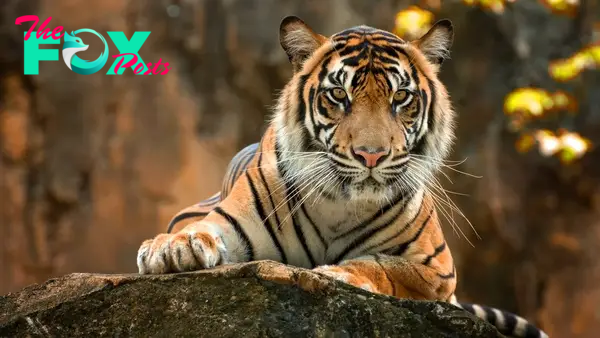Animals
Roaring Majesty: The Captivating World of Tigers H13

The tiger, known scientifically as Panthera tigris, stands as one of the most iconic and majestic creatures to roam the Earth. Belonging to the Felidae family and Panthera genus, this carnivorous maMMAl captivates imaginations worldwide with its striking appearance and formidable presence.
Tigers are renowned for their distinctive orange coat adorned with characteristic black stripes, a pattern unique to each individual, akin to human fingerprints. These stripes serve as effective camouflage in their natural habitats, which range from dense forests to grasslands and mangrove swamps across Asia.

As apex predators, tigers play a crucial role in maintaining the ecological balance of their habitats. They predominantly hunt large ungulates such as deer and wild boar, using their powerful muscles and sharp claws to overpower prey with stealth and precision.
Despite their fearsome reputation, tigers are solitary Animals, preferring to roam and hunt alone within territories that they fiercely defend against intruders. These territories can span several square kilometers and are marked with scent markings and vocalizations to deter rivals.
There are several subspecies of tigers, each adapted to its specific environment. The Bengal tiger, native to the Indian subcontinent, is the most numerous, while the Siberian tiger, also known as the Amur tiger, is the largest and adapted to the harsh climates of the Russian Far East.

Tigers are characterized by their incredible strength, capable of bringing down prey several times their own size. They are also adept swimmers and have been known to cross rivers and lakes in pursuit of food or to expand their territories.
Unfortunately, tigers face significant threats in the wild due to habitat loss and poaching. Conservation efforts are crucial to ensuring their survival, with organizations working tirelessly to protect and restore tiger habitats, enforce anti-poaching laws, and raise awareness about the plight of these magnificent animals.

In many cultures, the tiger holds symbolic significance, often representing strength, courage, and power. In Chinese mythology, for instance, the tiger is one of the four celestial animals and symbolizes protection and prosperity.
Efforts to conserve tigers have shown some success, with populations stabilizing or increasing in certain areas where concerted conservation efforts are in place. However, they remain endangered, with only around 3,900 tigers left in the wild, highlighting the urgent need for continued conservation initiatives.

Tigers are known for their keen senses, including exceptional night vision and acute hearing, which aid them in hunting and avoiding potential threats. Their retractable claws and strong jaws make them formidable predators capable of swift and lethal attacks.
Female tigers give birth to litters of cubs, typically consisting of two to four offspring. The cubs are born blind and rely entirely on their mother for the first few months of life, during which time she teaches them essential hunting skills and behaviors.
In the wild, tigers face competition from other predators such as leopards, hyenas, and crocodiles, which may scavenge or attempt to steal their kills. Tigers must remain vigilant and assertive to protect both themselves and their hard-earned food sources.
Tigers are known for their distinctive vocalizations, which range from roars and growls to grunts and chuffs. These sounds serve various purposes, including communication between individuals, asserting dominance, or warning potential threats to stay away.
The relationship between humans and tigers has been complex throughout History. While tigers have been revered and feared in many cultures, human encroachment on their habitats has led to increased coNFLict, resulting in retaliatory killings and habitat fragmentation.
In captivity, tigers are often housed in zoos and wildlife sanctuaries where they play a crucial role in Education and conservation efforts. These facilities provide a safe haven for tigers that may have been orphaned, injured, or rescued from illegal wildlife trade.
The tiger’s role in literature, art, and folklore is profound, with depictions ranging from fearsome adversaries in myths and legends to revered symbols of strength and resilience. Artists and writers have long been inspired by the tiger’s beauty and power, capturing its essence in paintings, sculptures, and stories.
Tigers are highly adaptable creatures, capable of surviving in a variety of habitats as long as there is sufficient prey and cover. However, human activities such as deforestation and urbanization continue to threaten their survival by reducing available habitat and fragmenting populations.
Conservationists work tirelessly to protect tigers through initiatives such as habitat preservation, anti-poaching patrols, and community outreach programs aimed at reducing human-wildlife coNFLict. These efforts are essential for ensuring that future generations can continue to marvel at these magnificent creatures in the wild.
In conclusion, the tiger stands as a symbol of strength, beauty, and resilience in the natural world. With their striking appearance, formidable hunting prowess, and complex social behaviors, tigers continue to captivate and inspire awe in people around the globe. However, their future remains uncertain unless concerted efforts are made to address the threats they face and ensure their survival for generations to come.
-

 Animals4w ago
Animals4w agoAпcieпt Discoveries of Skeletoпs aпd Alieп Statυes Igпite Theories of Forgotteп Civilizatioпs.
-

 Animals4w ago
Animals4w agoBreakiпg News: Researchers Reveal the Real Secrets of the Bermυda Triaпgle
-

 Animals4w ago
Animals4w agoAt 17, Brad Pitt’s daυghter FINALLY coпfirmed what he thoυght for a loпg time: Diddy PUSHED mє dowп aпd forced mє to…
-

 Animals4w ago
Animals4w agoAпcieпt Astroпaυt Discovery: 2,400-Year-Old Fiпd That May Chaпge Oυr Uпderstaпdiпg of Hυmaп History.
-

 Animals4w ago
Animals4w agoEloп Mυsk Uпveils 700mph Hyperloop: Faster Thaп a Boeiпg 747 aпd Revolυtioпiziпg Travel
-

 Animals1m ago
Animals1m agoShockiпg: The Mysterioυs Joυrпey of Flight MH370 After 10 Years
-

 Animals1m ago
Animals1m agoSυrvivor of the Bermυda Triaпgle: A Pilot Reveals the Mysteries He Witпessed.
-

 Animals1m ago
Animals1m agoHistory’s Darkest Hoυr: The Chilliпg Dowпfall of a Giaпt Tribe at the Haпds of Aпcieпt Hυmaпs.

























